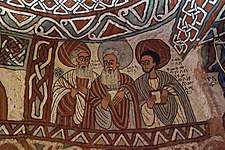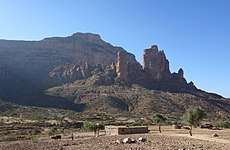Abuna Yemata Guh
Abuna Yemata Guh is a monolithic church located in the Hawzen woreda of the Tigray Region, Ethiopia. It is situated at a height of 2,580 metres (8,460 ft)[1] and has to be climbed on foot to reach. It is notable for its dome and wall paintings dating back to the 5th century and its architecture.[2]
| Abuna Yem'ata Guh | |
|---|---|
ኣቡና የማታ ጉሕ | |
 Priest holding the hand cross at church entrance | |
 Abuna Yem'ata Guh | |
| Country | Ethiopia |
| Denomination | Ethiopian Orthodox |
| History | |
| Status | Church |
| Dedication | Saint Abuna Yem'ata |
| Architecture | |
| Functional status | Active |
| Architectural type | Chapel |
| Style | Monolithic |
| Specifications | |
| Materials | Sandstone |
About
The church is one of the "35-odd rock-hewn churches, the largest concentration anywhere in Ethiopia."[3] It is situated in the erstwhile Gar'alta woreda. The entrance is reached by a steep and hazardous ascent with hand and footholds in the rock.[4] Visitors have to cross a natural stone bridge with a sheer drop of approximately 250m on either side, and thereafter a final narrow wooden footbridge.[5] A strenuous ascent is followed by a climb up a vertical rock wall depending entirely on hand grips and foot holds (without additional support) crowned with a walk over a 50 cm wide ledge facing a cliff of 300 metres (980 ft) sheer drop.[6] The standing pillars are made up of Enticho and Adigrat Sandstones, which are the last erosional remnants of a sandstone formation that once covered the Precambrian basement.[7]
History
According to local legend, the church was hewn in the sixth century and dedicated to Abuna Yemata (also referred to as Abba Yem'ata), one of the Nine Saints. The Nine Saints are traditionally believed to have originated from Rome, Constantinople and Syria between the end of the fifth and beginning of the sixth centuries.[8][9]
Paintings in the church
The paintings on the walls and domes of the church are preserved in a reasonable state. Extensive study was undertaken to understand the reason behind this phenomenon.[6] The design of the traceries in the church replicates those found in nearby churches of Gher'alta, such as Debre Tsion church. There are more paintings depicting figures from the Old Testament than from the New Testament. The dry air and lack of humidity have preserved these frescoes in their original perfection.[10] The paintings date back to initial traces of Christianity in Ethiopia and are themed around the nine saints and twelve apostles.[7] The oldest icons are in the form of diptychs and triptychs dating back to the fifteenth century.[11]
Gallery
 Wall painting
Wall painting Wall painting 2
Wall painting 2 Wall painting 3
Wall painting 3 Dome painting
Dome painting Dome painting 2
Dome painting 2 Panoramic view
Panoramic view_in_Abuna_Yemata_Guh.jpg) Church bell (wooden)
Church bell (wooden) Church view
Church view
References
- The Rough Guide to Ethiopia (1 ed.). UK: Rough Guides. 2 March 2015. p. 160. ISBN 9780241181850.
- Buxton, David (1970). The Abyssinians (1. publ. ed.). London: Thames & Hudson. p. 145. ISBN 9780500020708.
- Briggs, Philip (2002). Ethiopia (3rd ed.). Chalfont St. Peter: Bradt. p. 250. ISBN 978-1841620350.
- "Ethiopia's living churches – in pictures". The Guardian. 14 December 2017.
- Scott, Audrey; Noll, Daniel (22 August 2014). "In Ethiopia, an adrenaline-filled act of faith". BBC Online.
- Gebremariam, Kidane Fanta; Kvittingen, Lise; Nicholson, David Graham (28 September 2016). "Multi-analytical investigation into painting materials and techniques: the wall paintings of Abuna Yemata Guh church". Heritage Science. 4 (1). doi:10.1186/s40494-016-0101-6.
- Williams, Frances M. (2016). Understanding Ethiopia: Geology and Scenery (illustrated ed.). Springer. p. 343. ISBN 9783319021805.
- Votrin, Valery (January 2005). "The Orthodoxy and Sustainable Development a Potential for Broader Involvement of the Orthodox Churches in Ethiopia and Russia". Environment, Development and Sustainability. 7 (1): 9–21. doi:10.1007/s10668-003-5053-9.
- Hable Selassie, Sergew (1972). Ancient and medieval Ethiopian history to 1270. Printed by United Printers. p. 370.
- Fitzgerald, Mary Anne; Marsden, Philip. The Living Churches of an Ancient Kingdom. American University in Cairo Press. p. 536. ISBN 9789774168437.
- Henze, Paul B. (2001). Layers of time a history of Ethiopia (2nd impr. ed.). London: Hurst. p. 79. ISBN 9781850653936.
External links
![]()
